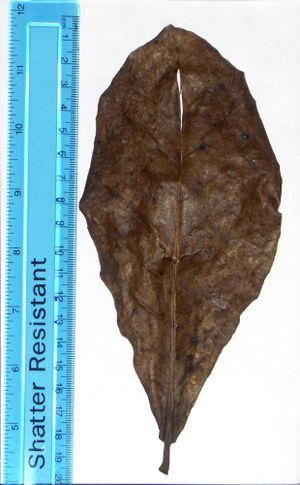Terminalia catappa
Contents
What is it?[edit]
Terminalia catappa is a species of tropical tree that grows in Asia. It is widely believed that placing the dried leaves of this tree in your aquarium (especially with Betta fish) causes the animals better health and therefore longer life.
Alternative Names[edit]
Indian Almond leaf, Ketapang, Wild Almond, Badamier, Java Almond, Amandier de Cayenne, Tropical Almond, Myrobalan, Malabar Almond, Singapore Almond, Ketapang, Huu Kwang, Sea Almond, Kobateishi, West Indian Almond, Umbrella Tree, Amandel Huu Kwang, Kottamba
Benefits[edit]
Unsubstantiated claims of a reduced presence of fungus, boosted immune system and helping skin problems in fish are also reported.
The leaves do contain several flavonoids (like kamferol or quercetin), several tannins (such as punicalin, punicalagin or tercatin), saponines and phytosterols. Due to this chemical richness, the leaves (and also the bark) have long been used in different traditional medicines for various purposes.
It is also thought that the large leaves (7-10" long) contain agents for prevention of cancers (although they have no demonstrated anticarcinogenic properties) and antioxidant as well as anticlastogenic characteristics.
In fishkeeping the leaves are also used to lower the ph and heavy metals of the water. It has been utilized in this way by Betta Breeders in Thailand for many years. Hobbyists across the world also use them for conditioning the betta's water for breeding and harding of the scales.
Studies of rotting plant material (see bogwood) have shown that the organic material releases minerals as beneficial fungi and bacteria decompose it. This provides food for infusoria which in turn shrimps and fry enjoy eating as a natural diet.
Does it work?[edit]
Scientific sources of the benefits of Indian almond leaves to humans are few and far between. Certainly chemical analysis of these leaves show a high degree of variety of chemicals. We can find no similar scientific studies on the benefits of this leaf in aquariums.
Perhaps similar benefits may also be seen if you were to use standard bogwood in your aquarium. Bogwood is well known at lowering pH and reduces the toxicity of metals. Which is an aid to lowering the presence of fungus and certain species of bacteria. The organic matter is also as a food source for catfish like Plecos and is a natural food for infusoria which invertebrates like shrimp and other small fish feed off.
The tannins and other chemicals which are dissolved in the water by the decomposition of organic material is called Blackwater. There are many companies selling Amazon and African blackwater bottles. So Indian almond leaves may simply be Asia's equivalent.
Certainly aquatic animals evolved alongside trees growing next to them. Tree leaves falling in and decomposing will have released dozens of trace minerals that the animals will have naturally absorbed. In an aquarium these chemicals will be missing so it seems sensible to assume that adding these chemicals via blackwater or bogwood will potentially restore this imbalance. The trick is to obtain the same species of plants that grow in the wild animals locale.
Failing that, other plants like Green tea, Tree spinach, Dock leaves, Cranberrys, etc. are all well known for their health benefits. Oak leaves are often used in aquariums as an alternative.
Purchasing the leaves[edit]
The leaves are now generally sold commercially in aquarium shops. eBay and AquaBid often have sellers of these items. The leaves are not expensive.
- The leaves should be evenly brown on both sides with no signs of fungus mould (light grey patches). Give the leaf a rinse in tap water to remove any possible lingering pesticides, etc. before you add it to an aquarium is a prudent move.
- Keep any unused leaves in an air and watertight container away from light and heat will ensure that any unused leaves will keep for at least 4–6 months.
Indian almond leaves and Betta fish[edit]
There appears to be word-of-mouth speculation of this leaf being used by far eastern aquarists for hundreds of years to harden the skin and increase the health of this fighting fish after bouts of fights.
Dosage[edit]
Assuming an average 15.2-25.4cm (6-10") long leaf, you use one quarter of this for every 4 Litres (1.1US G.) litres for Bettas or 1-2 leaves per 50 Litres (13.2US G.) for other species. Leave them in the tank for around 15 days in a filter bag or let them lie loose, they will sink after 2–3 days. Expect the water to tint slightly brown with the tannins.
- Remove any active carbon before adding them. Afterwards carbon may be used to remove the tannins but this may impact on their benefit.
Alternatives[edit]
- See Oak Leaves
